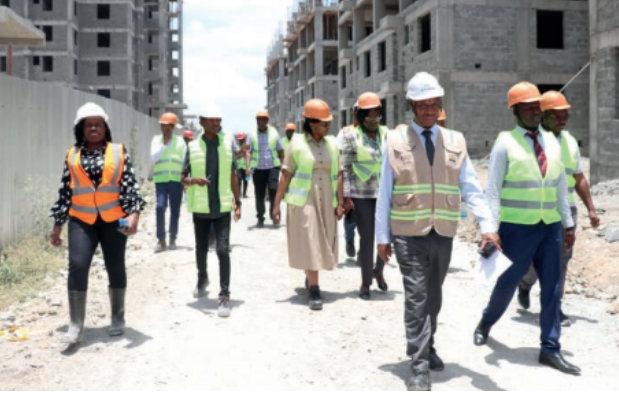The government is set to begin handing over bedsitters at the Sh7 billion Mukuru Affordable Housing Project in December, according to the State Department for Housing and Urban Development. They are working closely with contractors on-site to accelerate the construction of the project, which is being funded through the Housing Fund on a 56-acre plot of land that was originally grabbed by private developers before being recovered by the Ethics and Anti-Corruption Commission and handed over to the government in 2020.
The Mukuru project is the largest single housing initiative being developed by the government, comprising 13,248 units. These include 26 blocks of bedsitters (5,616 units), 14 blocks of one-bedroom units (3,024 units), and 48 blocks of two-bedroom units (4,608 units).
Benjamin Njenga, the Secretary for Urban and Metropolitan Development at the State Department for Housing and Urban Development, stated, “Phase I of the bedsitters is 99 percent complete, Phase II is at 80 percent, while Phase III is at 60 percent.
The President will start distributing the units from December. Our main focus is on the residents of Mukuru slums as we work on these key projects aimed at replacing slums with decent housing units across the country.”
The rent for bedsitters will be Sh3,000 per month on a rent-to-own basis, payable over 30 years, excluding service charges. One-bedroom units will go for Sh4,000, while two-bedroom units will cost Sh5,000 per month.
Njenga further explained that the Housing Fund is crucial for accelerating the project, which has already created over 3,000 jobs and involves local artisans (Jua Kali) in supplying fittings such as doors and windows. Construction of the two-bedroom houses at Mukuru began in March this year, with a completion target set for March 2026.
The project is being executed by three contractors: M/s Vaghjiyani Ent. Ltd for the bedsitters, M/s Epco Builders Limited for the one-bedroom units, and M/s Top Choice Surveillance Ltd for the two-bedroom units.
“The Housing Fund is also essential for developing other affordable housing projects in various parts of the country,” Njenga added. Registration for the project is done through Boma Yangu, using a one-house-per-ID formula. Other housing projects in Nairobi include those in Shauri Moyo, Starehe, and Soweto in Kibra.
The government plans to build at least 200,000 homes annually to tackle the housing deficit in the country, where nearly 61 percent of urban households live in slums.
The Mukuru Affordable Housing Project is part of the broader Affordable Housing Programme, which falls under Priority No. 3—Housing and Settlements—in the Kenya Kwanza Manifesto. This priority is aligned with the national development blueprint, Kenya Vision 2030, which aims to deliver 250,000 homes annually. However, the market currently only produces about 50,000 homes per year.
According to the World Bank, Kenya’s housing deficit stood at two million units as of 2022, and the country needs to build 250,000 units annually for the next four years to close this gap. The World Bank highlights that this deficit continues to grow due to fundamental constraints on both the demand and supply sides, exacerbated by an urbanization rate of 4.4 percent—equating to 0.5 million new city dwellers each year.
To address this, the government is keen to bridge the 200,000-unit shortfall, with significant involvement from the private sector as part of President William Ruto’s ambitious housing plans. The World Bank notes that making housing more affordable could stimulate economic growth at both the national and county levels.
Housing and Urban Development Principal Secretary Charles Hinga emphasized that the government is progressively closing the housing gap by delivering affordable units through a combination of approaches involving both levels of government and private sector players. “These projects are at various stages of development,” he added.
President Ruto launched 51,666 housing units between September last year and January 2024, creating at least 168,431 jobs in different regions of the country. “This project has changed the lives of many youths in Kibera. People are even hoping it will create more jobs. The youth are ditching crime for meaningful employment,” an employee at the Kibera site shared.
With approximately 840,622 units in the pipeline, the State Department for Housing projects that the programme will create 2,738,902 jobs over the next five years.
To further enhance the programme, the government has identified pieces of land and floated them to developers for joint development. Other projects under construction across the country include the Mavoko Affordable Housing, Ruiru, Homa Bay, Embu, Thika, Gichugu, Bahati, Milimani in Kakamega, Vihiga Housing Estate, and Mabera Affordable Housing in Kuria West. Other notable projects include Mzizima Estate (Mombasa), Kidiwa-Kapsuswa, Pioneer AHP, Emgwen Affordable Housing Project, Timau Buuri, and two in Meru. Some projects, such as Buxton in Mombasa and Nakuru’s Bondeni Affordable Housing, have already been completed, with 605 units delivered.



